From AR/VR to drones, robots, holograms and more
American Football is one of the most popular sports in America. But it is also one of the most advanced sports leagues when it comes to emerging technologies.
Before we get into some of the technologies used in the NFL, let’s start with the economics. In 2018, the NFL generated about $15B, making it the king of U.S. sports. Moving forward, the NFL aims to grow its annual revenue to $25B by 2027.
Looking at TV ratings, the NFL has gained back viewers in 2018 but lost attendance that same year. In fact viewership across CBS, FOX, NBC, ESPN and NFL Network averaged 15.76M viewers, up 5% from the 2017 season, according to the Hollywood Reporter. At a time when other programming is seeing declines across the media landscape, the NFL’s lift in 2018 shows that the value of live sports content has increased.
In terms of attendance, the 2018 regular NFL season saw average attendance at 67,100, the lowest average since 2011. The Chargers were up the most, but that’s a bit misleading because their first season in LA was abysmal (average of 25,335) and they have should expected to sell out each week in 2018 given that they’ve been playing in the home of the MLS’s LA Galaxy, with a seating capacity of 27,000, until they get into the new location they’ll share with the Rams in Inglewood. Washington led the league in attendance decline, followed by Tampa Bay and Cincinnati.
 So could emerging technologies bring fans back to NFL stadiums? While we believe that some emerging technologies like AR/VR could become new drivers in the future, it is still too soon to tell. That being said, here is a quick overview of what we believe are innovative technologies used in the NFL.
So could emerging technologies bring fans back to NFL stadiums? While we believe that some emerging technologies like AR/VR could become new drivers in the future, it is still too soon to tell. That being said, here is a quick overview of what we believe are innovative technologies used in the NFL.
1. Standard AR apps:
Over the past few years, we’ve seen the emergence of a wide variety of AR sports experiences used in the NFL anywhere from AR-based digital cards, interactive games, and AR-powered selfies.
For example, the Minnesota Vikings (NFL) teamed up with Zappar to create an AR-enabled playbook for their home games. By embedding AR into their app, Vikings were able to use the thousands of program sales across the season to drive downloads and long-term engagement. In turn, fans could use the Vikings app to scan the programs to unlock interviews and gameday videos of their favorite players. This is just one of the many examples of AR experiences currently offered by NFL teams.
Video: Zappar, Minnesota Vikings (NFL)
2. AR & Live biometric data experience on live TV:
Over the past few years, sports broadcasters in the NFL have also been early adopters of AR for live sports on television. As illustrated below, one of the best examples of this has been sports broadcasters in North America who have teamed up with the NFL and Zebra to show the performance data of NFL players in real-time as AR overlays on live TV.
NFL players are equipped with Zebra’s RFID tags located in their pads that track the speed, velocity, and acceleration of players. Sports analysts can tap into this information during the broadcast to add additional analytical color — “Devin McCourty jumped the route and took it to the house for an 84 yard interception return, hitting the 22.05 miles per hour.” McCourty’s return was actually the fastest touchdown based on speed in all of 2018.
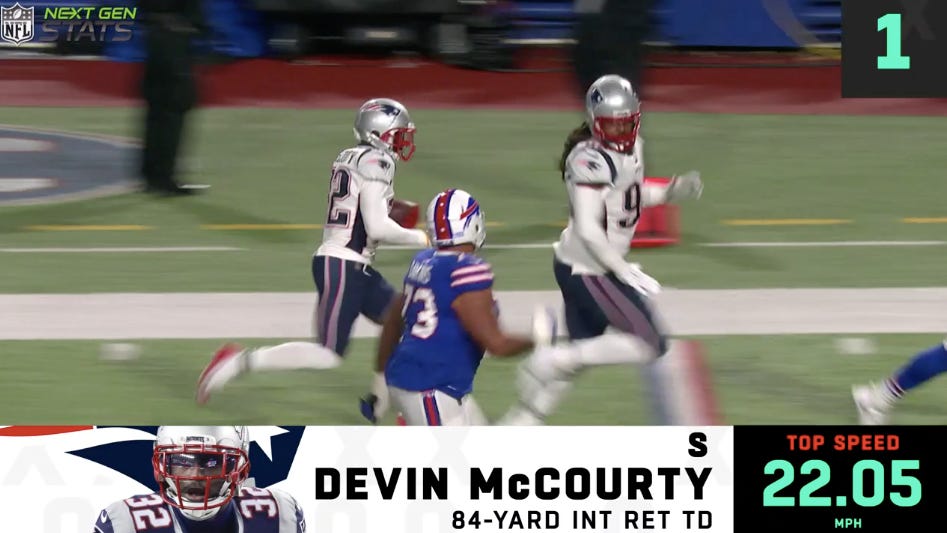 By comparison, in Australia, the NRL, a leading rugby league, has gone one step further and shared with fans the heart rate of coaches and players, captured via RFID and HR sensors, on live TV as an AR overlay during crunch time. In Japan, Panasonic teamed up with the Panasonic Open golf tournament, in order to show the HR and stress level of pro golfers on live TV. They were able to do that via facial recognition and algorithms.
By comparison, in Australia, the NRL, a leading rugby league, has gone one step further and shared with fans the heart rate of coaches and players, captured via RFID and HR sensors, on live TV as an AR overlay during crunch time. In Japan, Panasonic teamed up with the Panasonic Open golf tournament, in order to show the HR and stress level of pro golfers on live TV. They were able to do that via facial recognition and algorithms.
We believe that these type of AR sports experiences on live TV will become even more compelling — and ubiquitous — over time. Live betting capabilities will enable fans to bet on the next play after reviewing a critical play via an AR replay with valuable info (speed, hydration level, fatigue level) during live sports games on TV. These AR experiences will also help broadcasters increase viewership and bring new sponsors. Teams will also be able to attract new fans, new sponsors and drive the sales of their associated content (jerseys, hats, etc.) which will help increase their top line.
But these types of innovatives AR experiences could also emerge in NFL stadiums as well. In fact, we see a world where NFL fans will be walking around Levi’s Stadium wearing a pair of AR glasses displaying live statistical and biometric data (hydration level, blood pressure, HR, stress level, etc.) of players in real-time as an AR overlay. They will also be able to bet in real-time via 6G on the next play after viewing live performance data through a pair of AR glasses or an AR app.
3. VR training:
Over the years, VR training has also gained in popularity among NFL teams. STRIVR Labs, a Bay Area startup, and WIN Reality, have done a great job building a solid business in this area.
A few years ago we talked to Derek Belch, CEO of STRIVR Labs, who talked to us about the immediate value of VR for athletes, and especially for American football. One of the key benefits were training the athlete’s mind without exerting physical fatigue. Derek provided us with a relevant example stating:
“In February, I sat down with Kevin Hogan, the quarterback for the Stanford Cardinals. Kevin used our product every Friday to experience every play to enhance his visualization. When they played Notre Dame that year, his completion rate was 17-21, with 274 passing yards, 4 touchdowns and no interceptions. Because he could immerse himself into the footage, he said post-game it was a joke how easy it was to see blitzes coming before it happened.”
This example illustrates the utilization of VR has proven itself as a useful tool for NFL quarterback performance as mental preparation drills through technology have been beneficial in reading scenarios during actual games.
So what’s next in the world of VR sports training in the NFL?
Over the past 12 months we have seen the emergence of a new generation of VR sports training systems. Those training systems are using players’ live biometric data (e.g. speed of swing, HR, etc.). As illustrated in the picture below, companies like Trinity VR have built VR training systems using players’ biosensor data for MLB teams enabling baseball players and coaches to get real time feedback of the quality, speed of their swing. We expect similar VR training systems to emerge in the NFL where coaches will be able to get real time feedback about the biometric data of NFL players as they are going through virtual scenarios.
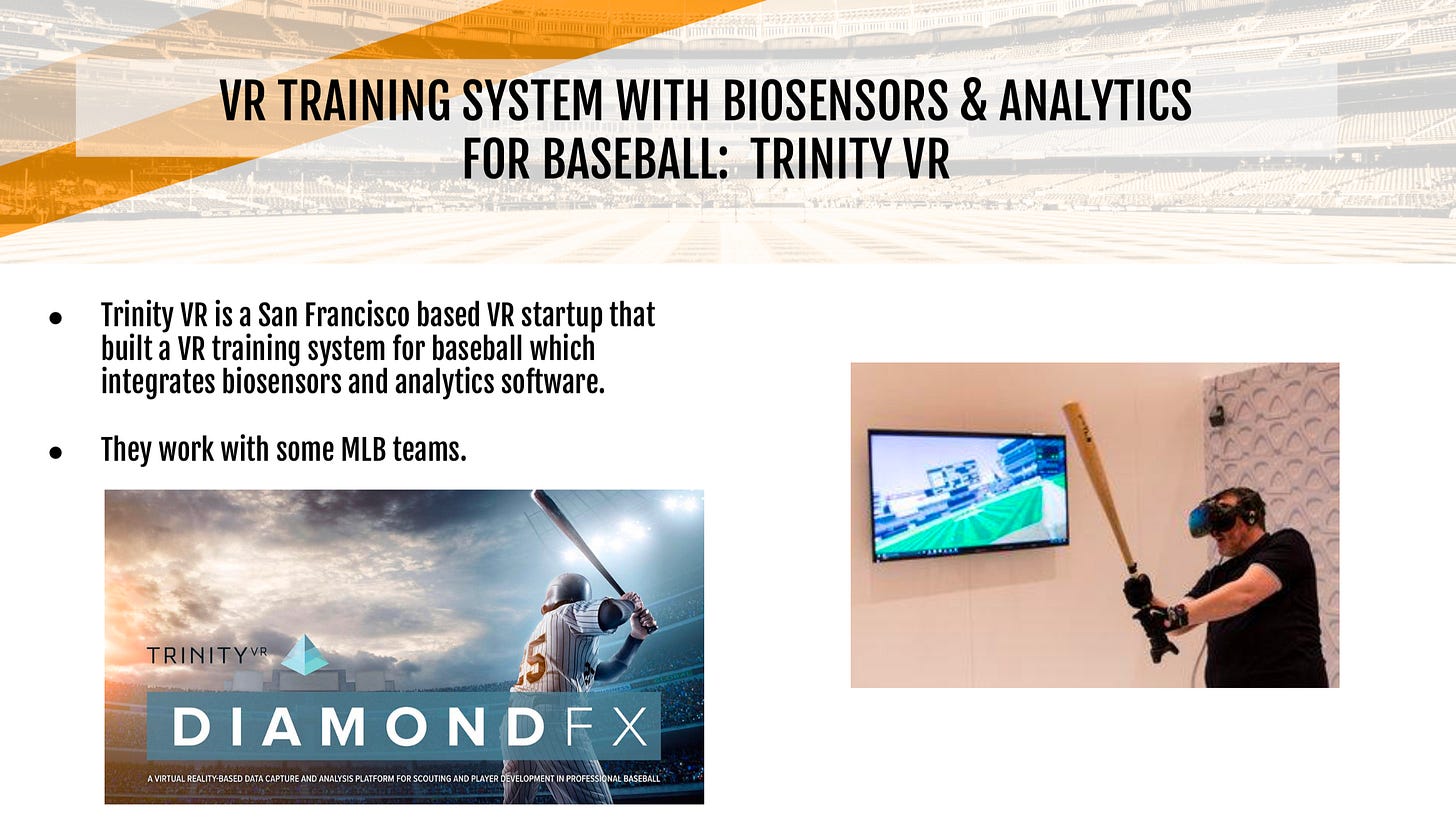 Source: Trinity VR, Sports Tech Advisors, 2019.
Source: Trinity VR, Sports Tech Advisors, 2019.
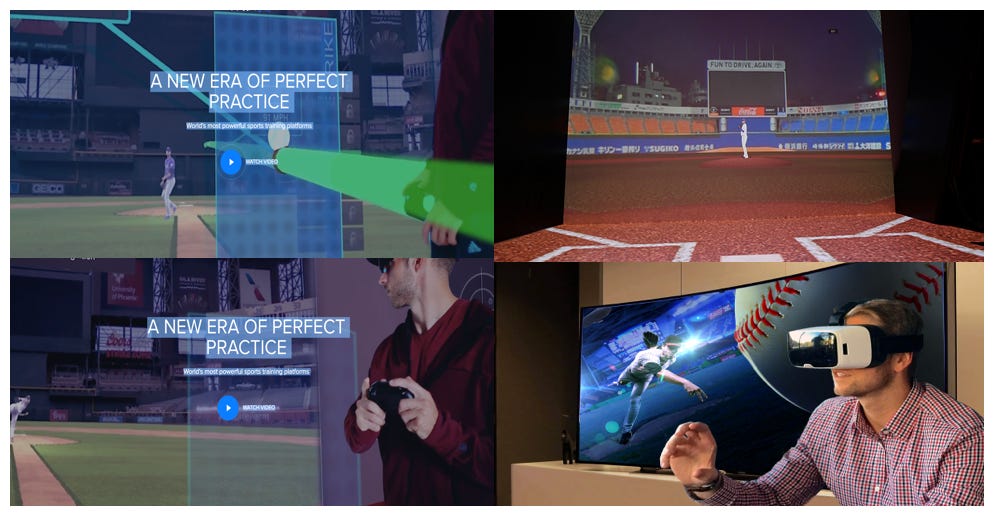 Picture: WIN Reality’s VR training system for baseball players
Picture: WIN Reality’s VR training system for baseball players
In the future, we expect those VR training systems to use more advanced biosensors that will enable NFL coaches to measure new types of biometric data such as hydration level, human power, fatigue level, lactic acid, core body temperature, electrolyte, protein…Startups like Kenzen built a smart patch that can measure HR, CBT, and sweat rate in time. This is the kind of startups that are likely to be integrated into those VR training system.
We could imagine a VR training system capable of both measuring the players’ hydration level as well as recommending how much electrolyte the player would need to be fully re-hydrated. That would be very insightful and would help the VR training systems get to the next level.
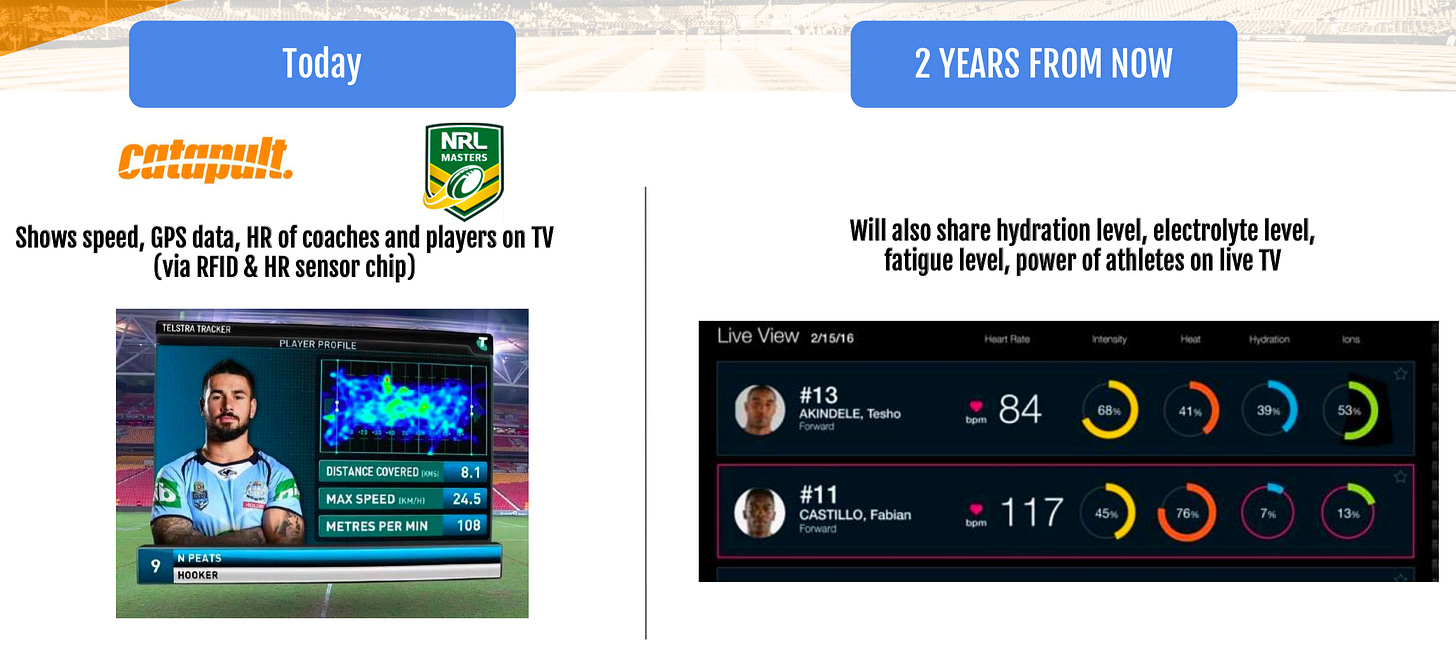 Source: Kenzen, NRL, Catapult, Sports Tech Advisors, 2019
Source: Kenzen, NRL, Catapult, Sports Tech Advisors, 2019
- Drones:
Drones are also emerging as a key new emerging technology in the NFL in order to help improve the training process but also to provide new types of fans experiences.
It is also worth pointing out that the NFL became the first major sports organization to use drones in 2015, with the blessing of the FAA. In 2016, the Dallas Cowboys became the first NFL franchise to be given the green light by the FAA to use drones for training sessions.
So why did the Cowboys start using drones during training?
The bird’s eye view angle provided by a drone was unprecedented; providing a wide angle that can range from end zone to end zone. It also allows NFL coaches to view the play from multiple angles, which gives them the opportunity to effectively show players where they fit on the field in relation to their teammates, and better understand team doctrine. Cowboys’ head coach Jason Garrett told the Dallas Business Journal that the drone angle is very advantageous, as it gives you a chance to see all 11 players on offense and all 11 on defense, from a lower, wider angle.
But drones have also been used in the NFL to offer NFL fans new types of experiences. In fact, during Sunday’s 2019 Super Bowl in Atlanta, the NFL teamed up with Intel to create the first-ever live drone lightshow during the game’s halftime show. Intel and the NFL have also made advanced Intel True View highlights available for fans to relive the most exciting moments of the biggest game of the year.
You can more details on how Intel put together the drone show at the last Superbowl.
Video: Intel, Superbowl 2019
- Helmet cams:
Immersive cameras such as helmet cams or referee cams have also become part of the American Football experience over the years in order to provide a more immersive fans experience. One of the key technology enablers in this area is ActionStreamer, a tech startup that live streams from point-of-view cameras, debuted a first-of-its-kind quarterback camera during the 2019 Pro Bowl practices. Seahawks star Russell Wilson donned a custom helmet with an embedded camera to take the first on-field QBCam footage.
Broncos linebacker Von Miller and Packers receiver Davante Adams were among the other Pro Bowlers to wear ActionStreamer cameras. Wilson and Colts tight end Eric Ebron also wore the HelmetCams during Pro Bowl warmups as well as practices. Each device weighs less than 100 grams (about 3.5 ounces) and can capture footage at 1080p resolution and 60 frames per second. ActionStreamer’s engineers integrate the hardware into the helmets in their Cincinnati lab to make HelmetCams.
Video: ActionStreamer
NFL players are not the only early adopters of body cams. NFL referees, in recent years, have also been early adopters of ref cams. For example, a few years ago FOX Sports equipped American Football referees with GoPro cameras on their hats at select college football games including the Big Ten championship football game.
Of note, GoPro worked with FOX Sports and Big Ten officials to design the referee-worn hat that provided POV perspective from the field that was cut to during the live broadcast and used for social media.
Video: Big Ten Network
- Holograms:
Holograms have also been used in the world of American football. One of the key players in this emerging field is a Californian startup named VNTANA. VNTANA worked with Nike’s Experiential Agency, On Board Experiential, to create an hologram experience for eight Frisco, TX based schools. The event was brought to life using VNTANA’s Life-Size Hologram Display System, where hologram football players rose up through the floor of the locker room donning each team’s brand new jerseys revealing the new designs to the public for the first time. In the end, it helped significantly improve the fans experience (13K engagements on social media). The event was also attended by 400 people.
Video: VNTANA
- Training robots:
Lastly robots have also started to become part of the training experience as a way to improve players’ safety. Among the NFL teams that have been early adopters of robots during training are the Pittsburgh Steelers, Los Angeles Rams and Baltimore Ravens. Those NFL teams have used a robot called Mobile Virtual Players for their camps. Each robot, costing about $8,000, weighs between 160 and 180 pounds, runs a 5-second 40-yard dash and cuts in the open field.
You can check out the video below to see how the robots work as part of the training:
Video: MVP, robots
Bottom line: In the coming years, we expect the NFL to continue to be an early adopter of emerging technologies like AR/VR, drones, wearables / advanced sensors, helmet cams, holograms in order to help improve the fans experience and players’ safety. Like in many sports, American football teams are very cost conscious. So it remains critical for sports startups trying to make inroads into the NFL to offer a product that is reasonable and can provide great ROIs whether it is terms of injury reduction or revenue generation. So what’s coming next in terms of emerging technologies in the NFL? There is no doubt that the next Superbowl will give us a glimpse of the future…


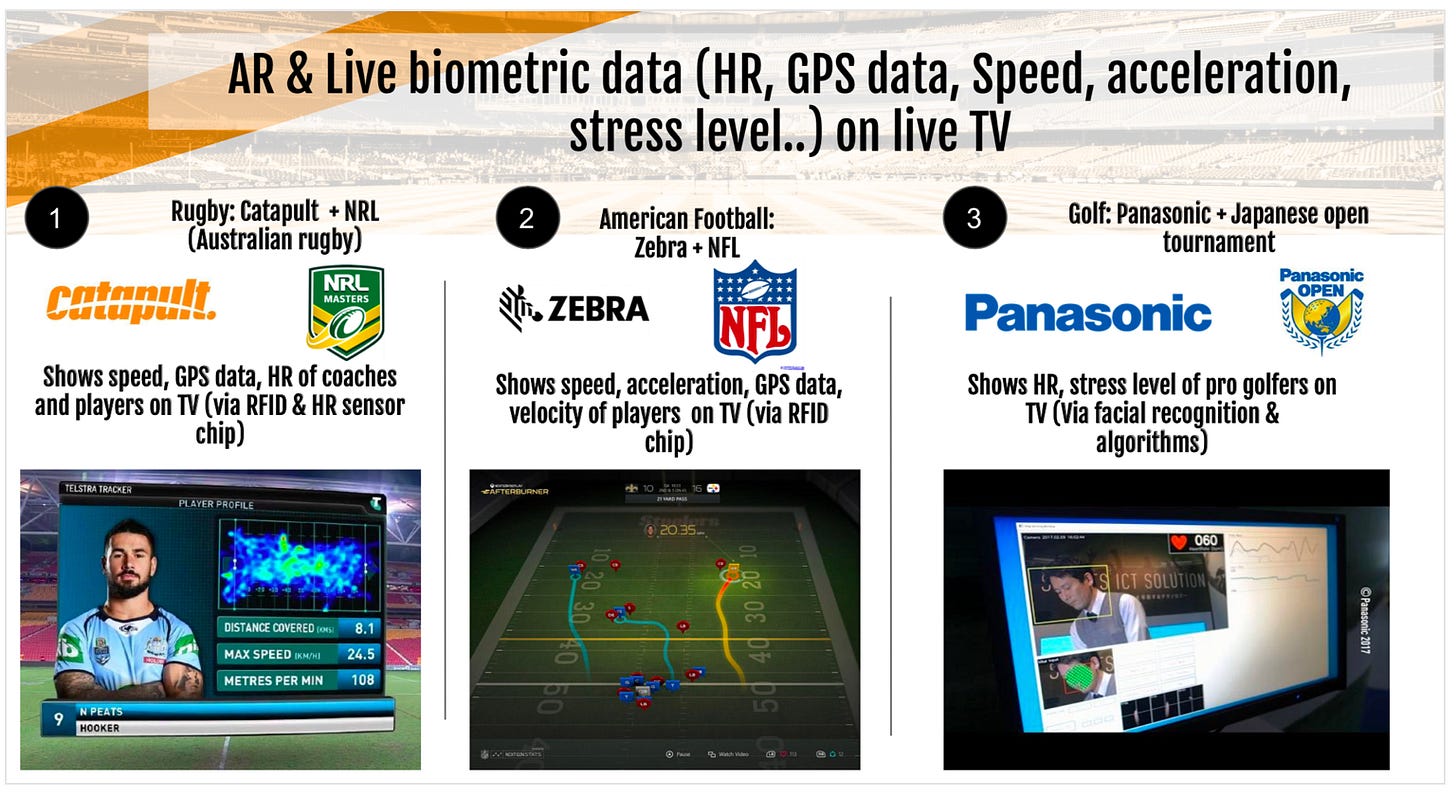
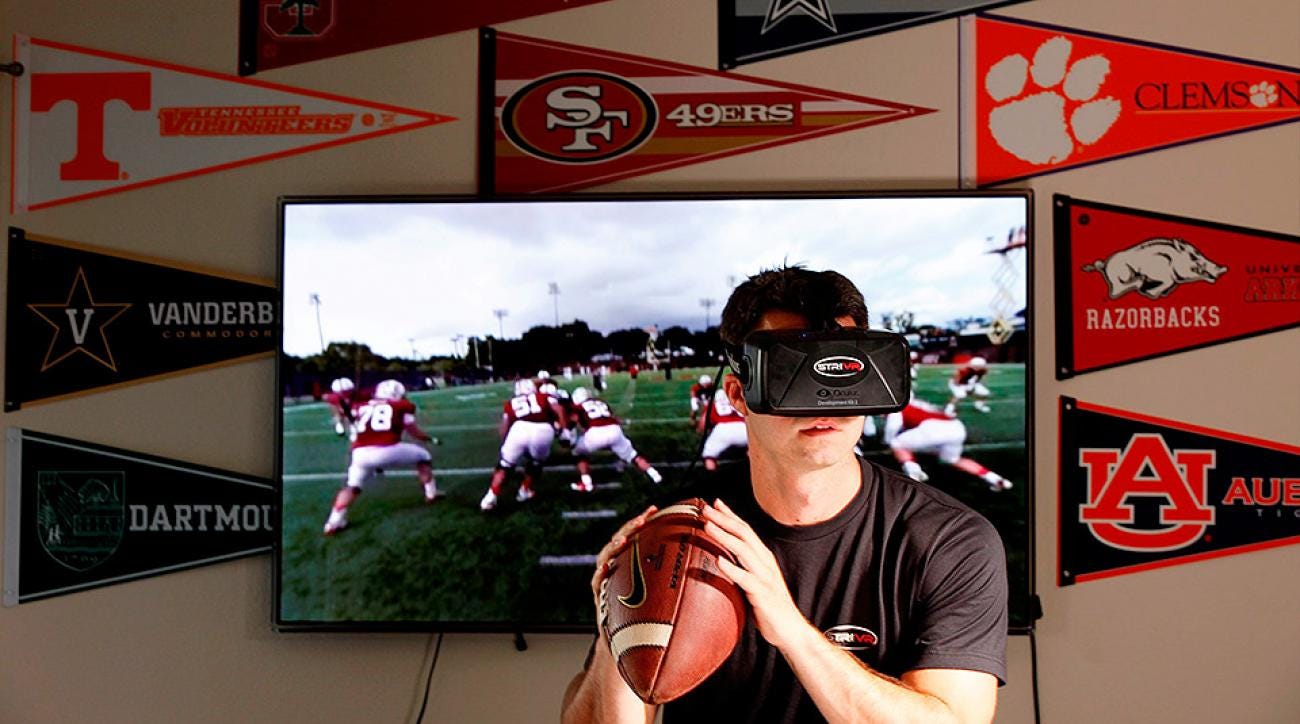
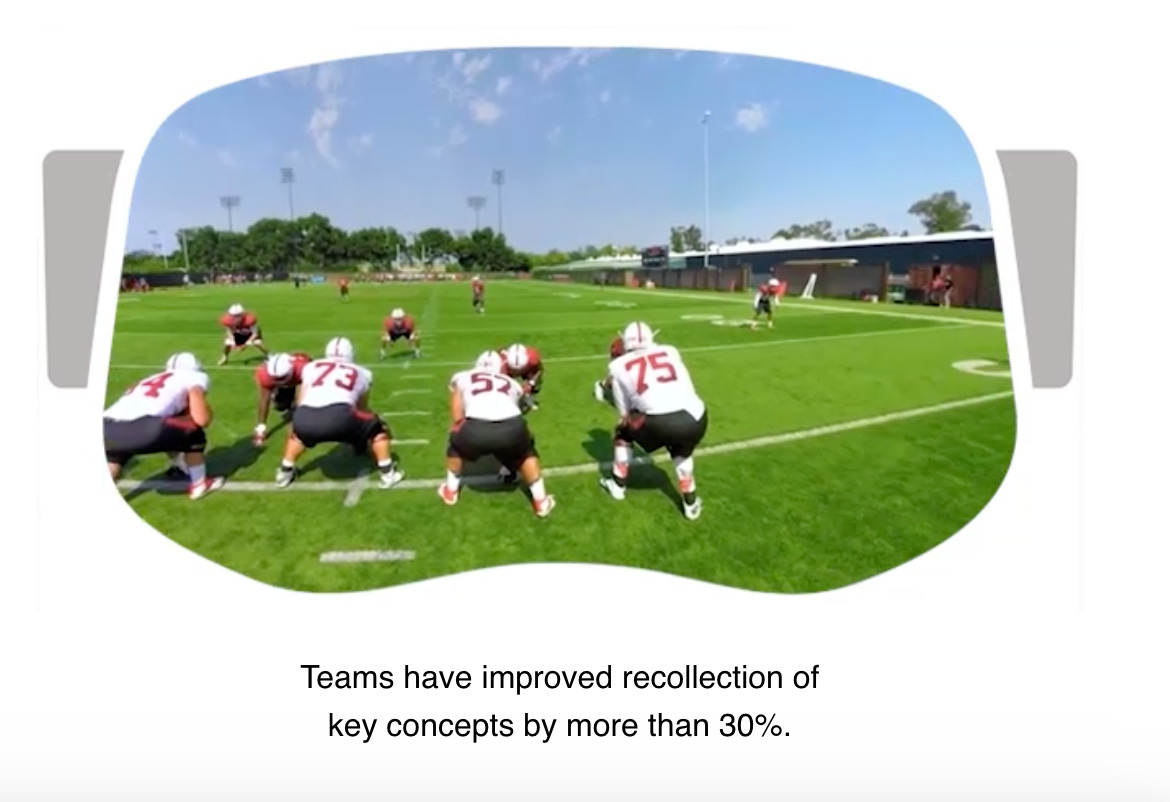
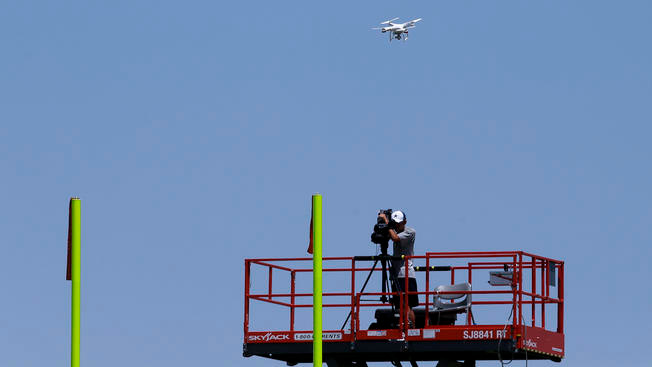
Leave A Comment
You must be logged in to post a comment.